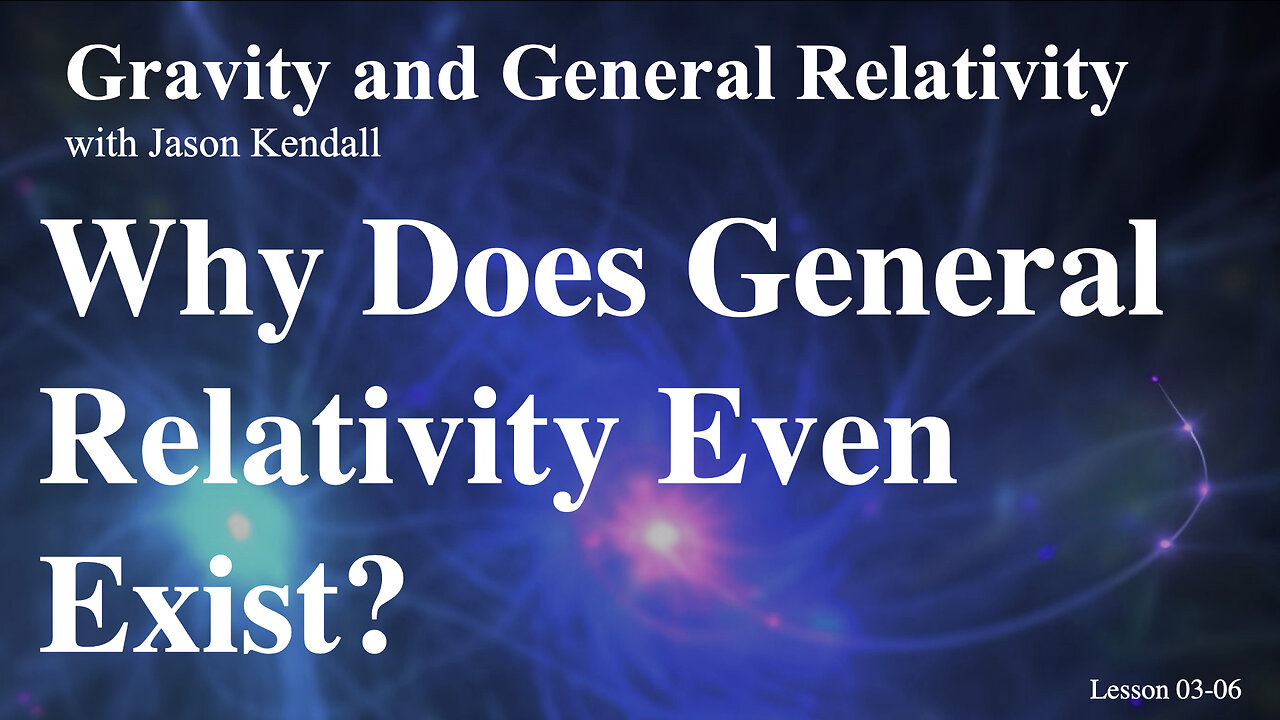Premium Only Content

Gravity Meets Special Relativity: Unlocking the Secrets of Spacetime!
In this introductory lecture, we delve into the relationship between gravity and special relativity. Previously, we explored special relativity and how spacetime is altered by the relative motion of two inertial frames. An inertial frame is defined as a region where all clocks and measuring sticks are aligned and uniformly moving through space, without any acceleration or deceleration. As we transition from the concepts of special relativity to the discussion of gravity, it is essential to recognize that gravity operates differently. When an object is dropped, it accelerates toward the ground rather than maintaining a constant speed. It is advisable to conduct a simple experiment at home. Drop an object from a short height and measure the time it takes to hit the ground. Then, drop the same object from a greater height to observe its acceleration due to gravity. You will find that the object indeed accelerates as it falls, reaching the ground faster as it descends. The acceleration due to gravity at the Earth’s surface is approximately 9.8 m/s². This means that for every second an object falls, its speed increases by 9.8 m/s. Thus, after the first second, it falls at 10 m/s, after the second second at 20 m/s, and so forth. In a gravitational field, objects accelerate downwards. Newton’s laws of motion also provide insight into the concept of acceleration. According to Newton, any force applied to a mass results in acceleration, and the resistance to that acceleration is termed inertial mass. Inertia is the property of an object that resists changes in its state of motion, whether it be its speed, direction, or rotation. Consequently, mass serves as a measure of an object’s resistance to acceleration. Given a known force applied to an object, one can determine its mass by observing the resulting acceleration. Less massive objects will accelerate more quickly than more massive ones. Interestingly, Newton also defined the force of gravity, which is proportional to the masses of the two objects involved, divided by the square of the distance between them. This presents an intriguing situation: the force due to gravity also depends on two masses, yet the understanding of mass in this context can lead to confusion. In Newtonian physics, when a mass is placed on a surface and pushed, it accelerates due to the applied force. If the same mass is held and subsequently dropped, it will also accelerate due to gravity. Therefore, it appears that the measurement of mass remains constant regardless of how it is evaluated, whether through resistance to motion or the force of gravity. However, this raises the question of why inertial mass and gravitational mass are seemingly the same. Einstein addressed this question in 1907, after developing the theory of special relativity. He posed two critical problems regarding gravity. The first involved the instantaneous nature of gravitational influence. According to Newton, if the mass of the Earth were altered, the effect on an object on Pluto would be felt instantaneously, despite the vast distance between them. This notion implies a communication of gravitational force that exceeds the speed of light, which contradicts the principles established by special relativity. The second problem Einstein identified pertained to the equality of inertial mass and gravitational mass. He suggested that while inertial mass is a measure of resistance to acceleration, gravitational mass behaves akin to a charge. In this analogy, the gravitational force experienced between two masses depends on their respective mass charges. If gravitational mass had been conceptualized first, it might have been viewed as a charge that resists acceleration, which leads to the conclusion that there is no inherent reason for these two types of mass to be the same. Newton himself did not provide a theoretical framework for understanding why gravity functions as it does. He simply acknowledged that his equations were successful in predicting various physical phenomena, including Kepler’s laws, the motion of planets, the precession of Earth’s rotation, and the tides influenced by the gravitational pull of the Moon and Sun. Newton’s gravitational theory was demonstrably effective, yet certain discrepancies awaited resolution. One significant observational issue arose with Mercury’s orbit around the Sun. Its elliptical orbit did not close perfectly; instead, it exhibited a shift, known as perihelion precession. Newtonian mechanics could account for a portion of this precession, specifically 531 arc seconds per century, but failed to predict the observed value of 574 arc seconds. This discrepancy prompted some scientists to consider modifications to Newtonian mechanics. Einstein approached this problem from a different perspective, proposing a connection between gravitational acceleration and inertial mass. He noted that when an object is dropped in a gravitational field, it experiences acceleration, leading to the hypothesis that the two masses might not only be coincidentally equal but fundamentally linked. In 1907, Einstein established the principle of equivalence, asserting that inertial mass and gravitational mass are identical. This conclusion had far-reaching implications. It suggested that the laws of physics apply equally to freely falling observers, regardless of whether they are located in a gravitational field or in space. This principle distinguishes general relativity from special relativity, which only addresses uniformly moving reference frames. To illustrate the principle of equivalence, consider an observer aboard the International Space Station, which is in orbit around the Earth. The astronauts aboard the station experience weightlessness, as they are in free fall toward the Earth while simultaneously moving laterally fast enough to maintain their orbit. This scenario exemplifies how freely falling observers perceive the same laws of physics as those situated far from any gravitational influence. The distinction between gravitational acceleration and acceleration due to other forces becomes clearer when considering hypothetical situations. For example, if a building were equipped with powerful rockets that provided upward thrust, the occupants would feel a force pressing them against the floor, indistinguishable from the force of gravity. In this scenario, there would be no way for them to differentiate between an upward acceleration caused by rockets and the downward pull of gravity. Thus, the equivalence principle asserts that gravitational acceleration and acceleration due to any force are indistinguishable. This insight allows for the extension of the principles of special relativity, which does not account for the effects of mass on spacetime, to incorporate the influence of mass. General relativity emerges from this synthesis, providing a framework for understanding how mass distorts spacetime. As we continue this exploration of gravity and special relativity, we will further investigate how the effects of mass influence the curvature of spacetime and the implications for our understanding of the universe.
-
 2:06:29
2:06:29
TimcastIRL
5 hours agoAirlines Cancel Over 700 Flights, Travel APOCALYPSE Is Now, Trump Says END FILIBUSTER | Timcast IRL
87K49 -
 LIVE
LIVE
SpartakusLIVE
10 hours agoTOXIC Solos on ARC Raiders || Friday Night HYPE - WZ or Redsec Later?
464 watching -
 2:15:42
2:15:42
TheSaltyCracker
2 hours agoWoke is DEAD ReeEEStream 11-07-25
42.4K118 -
 LIVE
LIVE
Sarah Westall
2 hours agoThe City of London: Infiltration, Intimidation & Centralized Power w/ Mike Harris
552 watching -
 10:14:18
10:14:18
Dr Disrespect
12 hours ago🔴LIVE - DR DISRESPECT - ARC RAIDERS - AGAINST ALL DANGER
147K22 -
 32:09
32:09
ThisIsDeLaCruz
23 hours agoFalling In Reverse: Christian Thompson’s Stage Tech Revealed
3.25K2 -
 LIVE
LIVE
SynthTrax & DJ Cheezus Livestreams
1 day agoFriday Night Synthwave 80s 90s Electronica and more DJ MIX Livestream 80s Night / Late Night Nostalgia
293 watching -
 4:05:52
4:05:52
Nerdrotic
7 hours ago $0.15 earnedHollywood REGRET | Disney's Predator | The Feminist Avengers - Friday Night Tights 379
36.9K12 -
 DVR
DVR
Mally_Mouse
4 days agoFriend Friday!! 🎉 - Let's Play! - MIMESIS
5.13K2 -
 41:20
41:20
MattMorseTV
3 hours ago $0.19 earned🔴Schumer just BACKSTABBED his OWN VOTERS. 🔴
18.9K39